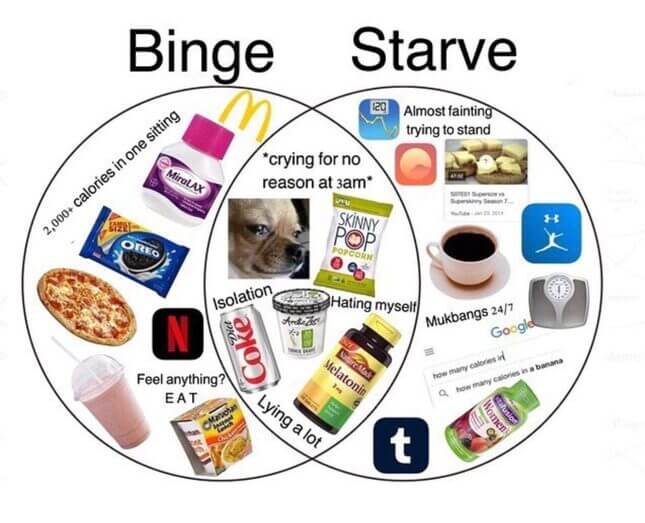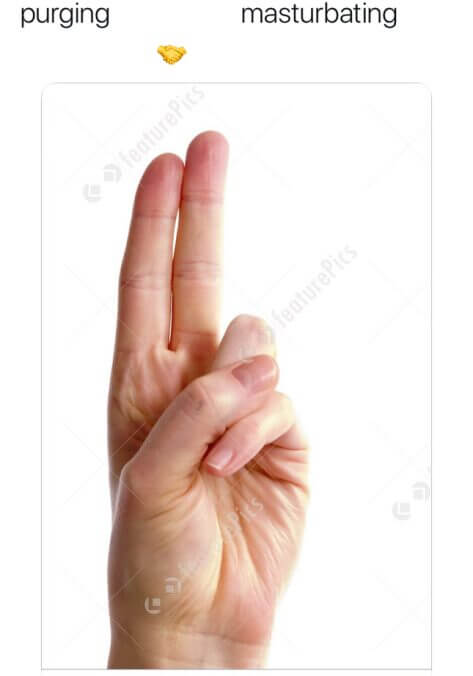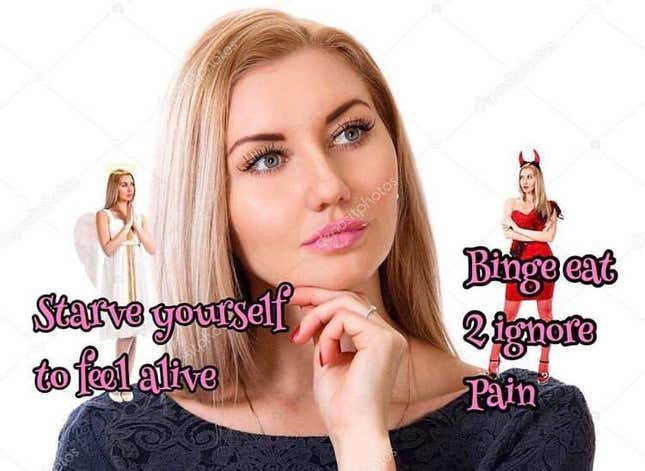
Image: Angelica Alzona/GMG
Online eating disorder subculture, pockets of the internet where largely young women and girls share inspiration and information on ED behaviors, has always been a black hole of calorie counting and exercising. Little has fundamentally changed since the days of pro-anorexia Livejournal communities, forums, and blogs of the aughts. There’s still thinspo (short for thinspiration; photos or videos of thin people) and shared tips on fasting, low-calorie foods, and working out. But if the Tumblr era of the early 2010s was defined by black and white GIFs of soft-grunge girls with thigh gaps, then the current Twitter era is defined by self-deprecating memes that add an element of dark humor with a dash of empowerment rhetoric to behaviors like fasting and purging.
ED Twitter is composed largely of teen girls and young adult women who are open with one another about their strained relationship with food. There are people with “ED vent” accounts who say they don’t promote eating disorders but simply want a space to gripe about their eating disorders without judgment. Many accounts explicitly note in their bios or pinned tweets that they’re not pro-ana (pro-anorexia) or other eating disorders. One Twitter user described the difference as such: “ED Twitter: vents about struggles they can’t talk about irl, offers support and shares content so people don’t feel alone; pro-ana Twitter: tweets pictures of Cassie from Skins with the caption ‘I haven’t eaten in three days so I could be lovely,’” referencing the British television show’s character Cassie Ainsworth, whose fictional anorexia has been glamorized for over a decade in eating disorder circles. The Twitter user then urged people to “PLEASE KNOW THE DIFFERENCE.”
Pro-ana sentiment is no longer acceptable among the young women and girls who currently contribute to ED Twitter. They have come of age during an era in which a certain woke savviness about mental illness and body positivity are part of the lingua franca. And at a time when anything and everything can be rebranded as empowerment, ED Twitter—and the specific brand of ironic internet humor that keeps it afloat—feels very much like the same enabling communities that came before. It’s just been repackaged with a “lmao.” That mix of empowerment and irony is only a surface posturing. Dig deeper and the lines between older forms of online ED communities and their current iteration seems to blur.
Jessica Betts, a registered dietician and eating disorder specialist, told Jezebel that while having a sense of humor about an eating disorder can be healthy, laughs should remain in the arena of recovery. “ED Twitter can also be triggering because well-intended posts can be interpreted in so many different ways. I’d argue so much of the need to not feel alone in struggles actually keeps these individuals stuck,” Betts said.
Like their predecessors, many participants in ED Twitter have usernames that include words like “skinny,” “bones,” “thin,” “cal” (short for calories), “craving,” “zero,” “starve,” etc. It’s common for people to list their current weight (cw) and goal weight (gw, or ugw for “ultimate goal weight”) in their bios. Some do “body checks” in the form of selfies that act in the same way that anybody’s selfie does: validation, but from their fellow ED sufferers who experiment with extreme calorie restriction diets or fasts.
Screenshots from fasting apps like Zero are common, as are tweets about Halo Top, a low-calorie, high-protein ice cream with aesthetically pleasing packaging that, to these communities, feels “safe” to eat. (Neither Zero nor Halo Top responded to requests for comment on their popularity among girls and young women with eating disorders.)
Some list the number of days since they’ve binged in their Twitter names, both as a point of pride and of self-flagellation. There are posts about calorie counts, binging and purging, parents that don’t understand and IRL friends who are convinced of their recovery. There are wistful tweets about the model Kaia Gerber or the members of K-Pop groups like Blackpink and Red Velvet. To call these memes thinspiration may be a step too far, and semantics are deeply important here. They plead for soothing words from their followers in the wake of a binge. Followers usually oblige, reminding each other of the illusions of water weight and the importance of self-care. It’s not unusual to see a frantic tweet from someone in ED Twitter asking their followers if they should eat or skip a meal (followers will often encourage them to eat).
It’s popular to use a voice that blurs the lines between sincerity and internet irony. This isn’t special to ED Twitter, but in this corner of the internet, it feels uniquely dire. Depression memes about sleeping all day feel tame compared to memes about purging, thigh gap, and green tea fasts. Deciphering from hyperbole and sincerity becomes a fool’s errand.
I showed Betts a sampling of over 20 different memes and tweets that typify the attitudes and humor of ED Twitter. Betts was alarmed, especially by the cws and gws in people’s Twitter bios, which she described as “very triggering and absolutely pro-ana.”
“I find this incredibly disturbing—probably the most disturbing aspect of all of this actually,” said Betts. “It captures how important these peoples’ EDs are in their lives. They’re defined by them more than anything else.”



But for many, feeling stuck is better than feeling lost.
When browsing ED vent accounts on Twitter, it doesn’t take long to stumble upon ed_memes, a Twitter account with over 25,000 followers that posts relatable memes about eating disorders and mental health.
Ales, a pseudonym for the 20-year-old Dutch woman who created the ed_memes account in 2017 and runs it with six others, said that the question of whether or not “ED memes doing more harm than good points to the main issue of the entire community.” “Is having an online community of people with eating disorders doing more harm than good? Yes, it allows for people to connect, feel less alone, encourage each other to get help, but it can also be used as an escape from reality, as a place to trigger each other, or even worsen each other’s conditions.”
But for Ales, it’s worth the risk. It’s clear that she, as well as thousands of others, view ED Twitter as a form of survival.
It is easy to see why these communities still thrive. Most of the cultural discourse around eating disorders comes in the form of crass speculation about what celebrities may suffer from one; treatment options are often expensive or inaccessible; some ED sufferers who live in families or communities in which mental health issues—let alone eating disorders—are either woefully misunderstood or outright dismissed.
“We often get messages from people saying things like, ‘Hey, thank you for running this account,’” Ales said. “‘Your posts have made me laugh on days I thought I wouldn’t be able to, and they make me feel less alone.’”
Ales originally joined the Twitter ED community in 2012. “I had already been struggling with some mental health issues for a while,” said Ales via direct message. She was about to leave on a vacation with her family and she didn’t want to make a phone call and risk them overhearing her conversation; her parents don’t know about her eating disorder. “I was very depressed, sad, hated myself. I was already engaging in unhealthy dieting behaviors, and I decided to look up dieting tips on Google, which then led to me finding a pro-anorexia website. I quickly got obsessed with it.”
She then looked up “pro-ana” in the Twitter search bar, curious if she could find anything. She did.
“I quickly decided to make an account, hoping to make friends, have people help me lose weight, and have a place to be myself and talk about the things that were on my mind, as I could not share them with the people around me in real life,” said Ales.
But that might as well have been in the internet dark ages. Ales said that it’s hard to find Twitter accounts that explicitly encourage disordered eating. Accounts dedicated to posting images of excessively thin women are in the minority on Twitter. Meanwhile, searching for “skinny” in Tumblr’s hashtags pulls up a slew of thinspo and “meanspo”—in which users post mean-spirited content in an attempt to trigger ED behaviors—and “sweetspo”—in which users post flowery, motivational thought exercises to trigger ED behaviors. “Skinny girls don’t eat, and you won’t be pretty if you’re not skinny, right?” reads one meanspo Tumblr post, while a sweetspo post says, “Imagine in two weeks when your collarbones poke out more noticeably, imagine in two months when you see the difference in your thighs and stomach… You can finally be happy.” Even posts tagged “#ed recovery” are brimming with negativity.
It’s the kind of content that Ales says would be immediately reported by the ED community today if it made the rounds on Twitter. “The Twitter community has pretty much shunned them, and will report bomb them if they are found,” she said.
While the ED community on Twitter has some members who are active advocates of recovery, most hover in this slippery space between being anti-pro-anas, but not ready for recovery.
It’s this middle ground that Ales’s meme account appeals to. After she noticed that users were sharing memes and funny content about eating disorders, Ales decided to make a separate Twitter account dedicated to it. Ed_Memes features a variety of memes, like the “two buttons meme,” in which a conflicted individual must choose between two red buttons with contradicting results; the options ED_Memes chose were “not having an eating disorder” versus “wish my eating disorder was worse.” Another post featured the summoning circle meme (summoning: “a 15-year-old boy’s super fast metabolism”).
Several of the ED vent accounts retweet the memes from Ales’s account, as well as sardonic tweets made by others within the ED Twitter community. For example, a popular reaction video of a young girl doing a pageant strut in absurdly high heels; the text reads “this is how I’ll walk everywhere once I reach my gw.” And there are always the “ED culture” tweets too: “ED culture is eating out of a measuring cup”; “Ed culture is saying ‘stay safe’ to each other knowing damn well everything we’re all doing is the exact opposite of safe.”
Betts believes that these communities can be “hotbeds for people to learn new behaviors.” But Ales sees it differently. “Dealing with mental health issues day in day out can really get to you,” said Ales. “And being able to laugh about it helps.”
With such an isolating disorder, finding humor in the darkest aspects of your daily life can provide a much-needed lifeboat in the rough waters of depression, dysmorphia, and the infinite Instagram scroll of skinny influencers and models who promote their restrictive sugar-free diets.
Michelle Miller, a clinical assistant professor in the Department of Child and Adolescent Psychiatry at NYU Langone Health, echoed Betts’s concerns.
“Overall, my impressions are that the Twitter posts and memes are very problematic for eating disorder recovery,” said Miller. I showed her the same set of tweets that I showed Betts. “The posts are all about the eating disorder symptoms that people are experiencing, such as binge eating, purging or being underweight, rather than on recovering. They seem more like the pro-ana sites than people truly reaching out for help.”
It’s a charge that many in the ED Twitter community would adamantly deny. “We don’t glamorize mental illness,” Ales insisted. “We don’t promote it, we don’t create posts stating, ‘Hey look how cool it is to feel you have to throw up every meal, or want to die every day.’”
But ED culture is ultimately a reflection of the values that animate it. Maybe online ED subculture has just rebranded, just like every other facet of dieting, fitness, and health. If Kardashian-endorsed weight loss lollipops, skinny teas, and other dieting products can be sold as “empowering,” then ED subculture can easily access that framework. ED Twitter community is speaking a universal language which garners some mainstream appeal.
“There’s a lot of diet companies that are picking up on how ‘diet’ is kind of a poo-pooed word and people are catching onto the fact that diets don’t work,” said Betts. “So they’re changing the way that they describe their diets.” Think Weight Watchers’ shift to the streamlined and hypothetically less fraught name “WW.” Or clean eating behaviors, “detoxes,” and fasts that are essentially eliminatory crash diets in a shinier package.
“So much of what we see online is orthorexia,” Betts said. Orthorexia—a preoccupation with eating healthy food—isn’t officially recognized by the American Psychiatric Association as an eating disorder, but it is referenced regularly by eating disorder experts. “Focus on clean eating, good foods and bad foods, being the ultimate level of fitness… they’re behaviors that are hallmarks of eating disorders, but are also normalized in our culture.”
Even though the ED Twitter community doesn’t believe they’re encouraging others to adopt their behaviors, Betts says that constantly promoting thinness and dieting through their posts is part of the problem. “They just don’t understand what they’re doing,” Betts said.
Eating disorders and hospital visits due to eating disorders are reportedly on the rise, and whether this uptick is due to broadened awareness or the direct impact of social media and diet culture is unclear, the promotion of eating clean, easy access to meal and weight tracking apps, and the mainstreaming of weight loss supplements and fasts to younger audiences don’t help.
But the ED Twitter community thrives on each other’s shared disorders. And when their ED becomes a part of their identity, online and off, ED Twitter becomes a validation bender that never seems to end.
Ales’s Twitter account has a pinned tweet that says, “The scariest moment isn’t when you don’t want to eat and you do, it’s when you want to eat and you can’t.”
“It’s easy to be in denial about something when you think it’s what you want,” Ales explained. “But the moment you try to quit it and realize you can’t, that’s when fear will hit you.”
She was referring to eating disorders, but this sentiment is just as applicable to the ED community in general. When stepping away from the community may mean leaving behind those who helped feel better at your lowest, getting out may prove to be a wrench in the recovery process.
Nineteen-year-old Jordan Kocher has been in recovery for her eating disorder for three years. She posts recovery-centric content on her Twitter account and is skeptical of ED Twitter’s attempts to differentiate themselves from other eating disorder communities.
“[They] say they’re venting and not promoting, but if you have to say you aren’t promoting, you are promoting,” Kocher said. “If you weren’t promoting, you wouldn’t have to say you aren’t because nobody would accuse you of doing so.”
Kocher also thinks that while the kind of posts that make the rounds on ED Twitter can be relatable, the risk of these posts triggering others or causing someone to fall into a deeper hole is too high to justify. After all, there’s a seriousness to these disorders that shouldn’t be trivialized.
“The first time I got treatment, I was put in a wheelchair. The skin on my back was ripping. I have scars all over my back from it,” Kocher said. “I physically couldn’t do anything. The whole week before I was admitted I was in my bed crying. I couldn’t get up, I couldn’t make myself eat, I couldn’t do anything. It had gotten that bad because instead of telling me to get help, people said, ‘you can figure it out on your own, you can look online for ways to recover.’ But I only found ways to get worse.”
And that reality rarely becomes a meme; it doesn’t lend itself to dark humor or empowerment.
“I met someone who has osteopenia as a 26-year-old because she has been neglecting her body so much and she’s very close to having osteoporosis,” Kocher said. “I was close to having it too, and I’m only 19 about to be 20. So these illnesses that people joke about aren’t jokes and they shouldn’t be taken as jokes. They should be taken as seriously as possible.”
When I spoke to Ales about ED Twitter’s relationship with recovery, she said that it’s mostly positive, despite, from my observation, recovery-centric tweets being a rarity. She believes that three things hinder recovery for people who are in ED Twitter: They don’t believe they’re sick enough to recover (a common problem for people with eating disorders), they lack access to recovery resources, or they aren’t ready to face the underlying problems causing their disorder.
As for Ales’s recovery journey: It’s pending.
“I want to recover, eventually, but not until I have gotten to my goal,” Ales said. “Despite knowing it’s dumb to think that way, despite knowing that when I get there I still won’t be happy, I still talk myself into it. I won’t let myself recover from my disordered eating until I have reached my goal weight. That’s why for me it feels like limbo. I’m not sick enough to properly recover, nor well enough to actually live. I go back and forth every day on what to do, to try and live a happy life, or keep doing this until I die.”
If you or someone you know needs help, contact the National Eating Disorders Association (NEDA) online or at (800) 931-2237. If you have an emergency, text NEDA at 741741.